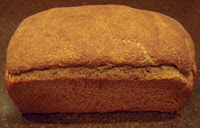 Having already done the Christmas breads, Hapanleipä and Vorterkaker are the last two international breads. These are very similar breads, one Finnish and one Norwegian. The challenge calls for making one or the other because of their similarity. Since the Norwegian bread is flavored with anise, I went with the other.
Having already done the Christmas breads, Hapanleipä and Vorterkaker are the last two international breads. These are very similar breads, one Finnish and one Norwegian. The challenge calls for making one or the other because of their similarity. Since the Norwegian bread is flavored with anise, I went with the other.As a rye, I went with hand mixing and kneading. Overall, the recipe was fairly straightforward and I didn't encounter any problems. The loaves are thin and almost cracker like. Actually, I wished I'd baked them a little longer and gotten a crisper result. Still a very pleasant loaf to be eaten like a cracker.
Next week it is on to bagels and flatbread. I'm looking forward to these!





